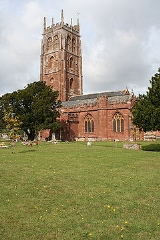
Church of St Mary, Bishops Lydeard
Encyclopedia
The Church of St Maryin Bishops Lydeard
, Somerset
, England dates from the 14th and 15th centuries and has been designated as a Grade I listed building.
In 1860–62 the church was extended by one bay and a vestry
, by Edward Jeboult of Taunton
, added.
The tower, which was built around 1497, has pierced tracery battlements, pinnacles, set back buttresses terminating in pinnacles at the bell-storey, and pinnacles on the buttresses at each stage.
Several of the tombs in the churchyard are of historical importance, as are two crosses, one dating from the 14th century, the other being the town's market cross which was moved to the churchyard in the 19th century.
Bishops Lydeard
Bishops Lydeard is a village and civil parish located in Somerset, England, bypassed, since 1967, by the A358 road and West Somerset Railway north-west of Taunton in the district of Taunton Deane...
, Somerset
Somerset
The ceremonial and non-metropolitan county of Somerset in South West England borders Bristol and Gloucestershire to the north, Wiltshire to the east, Dorset to the south-east, and Devon to the south-west. It is partly bounded to the north and west by the Bristol Channel and the estuary of the...
, England dates from the 14th and 15th centuries and has been designated as a Grade I listed building.
In 1860–62 the church was extended by one bay and a vestry
Vestry
A vestry is a room in or attached to a church or synagogue in which the vestments, vessels, records, etc., are kept , and in which the clergy and choir robe or don their vestments for divine service....
, by Edward Jeboult of Taunton
Taunton
Taunton is the county town of Somerset, England. The town, including its suburbs, had an estimated population of 61,400 in 2001. It is the largest town in the shire county of Somerset....
, added.
The tower, which was built around 1497, has pierced tracery battlements, pinnacles, set back buttresses terminating in pinnacles at the bell-storey, and pinnacles on the buttresses at each stage.
Several of the tombs in the churchyard are of historical importance, as are two crosses, one dating from the 14th century, the other being the town's market cross which was moved to the churchyard in the 19th century.

